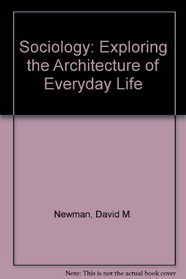Search -
Sociology: Exploring the Architecture of Everyday Life
Sociology Exploring the Architecture of Everyday Life
Author:
Excellence and Innovation for Teaching Introductory Sociology "I am a sociology teacher first and foremost. So I set out to write a book that is as helpful to the craft of teaching sociology as possible. You will not find a gargantuan summary of every sociological concept, topic, and theory here. Instead, I chose to limit the focus, al... more »
Author:
Excellence and Innovation for Teaching Introductory Sociology "I am a sociology teacher first and foremost. So I set out to write a book that is as helpful to the craft of teaching sociology as possible. You will not find a gargantuan summary of every sociological concept, topic, and theory here. Instead, I chose to limit the focus, al... more »
ISBN-13: 9780803990043
ISBN-10: 0803990049
Publication Date: 1/1995
Pages: 580
Rating: ?
ISBN-10: 0803990049
Publication Date: 1/1995
Pages: 580
Rating: ?
0 stars, based on 0 rating
Genres:
- Nonfiction >> Social Sciences >> General
- Nonfiction >> Social Sciences >> Sociology >> General





